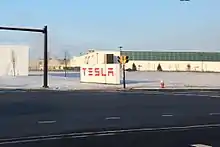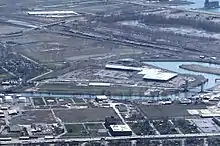Giga New York
Tesla Giga New York (or Gigafactory 2)[2] is a photovoltaic (PV) cell factory leased by Tesla subsidiary SolarCity in Buffalo, New York. The factory, owned by the State of New York, was built on brownfield land remediated from a former steel mill. Construction of the factory started in 2014 and was completed in 2016–17.
 Sign at factory entrance | |
 Location of Giga New York | |

| |
| Built | September 2014 |
|---|---|
| Operated | August 2017 |
| Location | Buffalo, Erie County, New York, U.S. |
| Coordinates | 42.859°N 78.840°W |
| Industry | Energy generation and storage |
| Products | Photovoltaic cells, Solar panels, Solar shingles |
| Employees | 1,500[1] |
| Address | 1339 South Park Ave, Buffalo, NY 14220 |
| Owner(s) | State of New York |
In 2013, the site of Gigafactory 2 was planned as a clean energy business incubation center. As SolarCity acquired Silevo in 2014 and merged into Tesla two years later, the factory was planned. The factory, in a partnership with Panasonic, started limited assembly of photovoltaic modules in 2017 using imported Japanese PV cells. It began commercial production of modules in 2017. In 2018, SolarCity began production of individual solar cells.[3] In late 2019[4] or early 2020 Tesla began commercial installation of version 3 of its "Solar Roof" product.[5]
By early 2020, Tesla had increased the number of employees at the factory to more than 1,500, but Panasonic stopped manufacturing solar panels at the factory in 2020.[6] Due to the COVID-19 pandemic, employment at the factory decreased in the first half of 2020.[5]
Early history


Background
Republic Steel and Donner Hanna Coke operated a steel mill along the Buffalo River on the 88-acre[7] South Buffalo site from early in the 20th century to its closing in 1984.[8] As a response to the regional manufacturing downturn related to deindustrialization in the Rust Belt, the State of New York created an economic stimulus package, later dubbed the "Buffalo Billion", providing $1 billion in unearmarked economic investments for the Buffalo area.[9][10] In 2013, Cuomo announced the Buffalo High-Tech Manufacturing Hub at Riverbend, targeting the Republic Steel site, then a brownfield, for the development of a clean energy business incubation center that was to be funded with $225 million from the Buffalo Billion fund.[11] At the time, the two companies announced as tenants were lighting manufacturer SORAA and solar panel manufacturer Silevo, which promised 475 jobs.[12][13] Development of the site would be managed by the SUNY Colleges of Nanoscale Science and Engineering, now SUNY Polytechnic Institute.[11]
In 2014, SolarCity detailed plans to acquire Silevo for $200 million,[14] subsequently scaling up plans for the Buffalo gigafactory. The company outlined a construction timetable and hiring goals promising an eventual 3,000 jobs in Buffalo with 5,000 statewide, and $5 billion in economic activity. The new plans abandoned the research center design in favor of the construction of a 1.2 million square foot factory. As a result, the state increased the incentives offered to $750 million.[15]
Construction and opening
Ground broke in September 2014. The facility was completed in late 2016 and was furnished with equipment through 2017. As of August 2017, production of solar panels had begun at the factory.[16]
Rationale

Before Tesla and Panasonic began their partnership in Buffalo, Panasonic already had 30 years of experience producing solar panels.[17] Because SolarCity incorporated the manufacturing process that Silevo had intended to use for production, the partnership allows Tesla to outsource production and reduce its burden on debt.[18] The technology used incorporates nanotechnology, an emerging sector in upstate New York that colleges and universities such as SUNY Poly and Erie Community College have developed programs and research in,[19] with the latter offering semiconductor and nanotechnology programs specifically for employment at the gigafactory.[20] The facility also takes advantage of tax incentives and leasable space from the State of New York. Tesla CEO Elon Musk has also suggested that the company's solar panels could be helpful in humanitarian crises, such as rebuilding the electric grid of Puerto Rico in the aftermath of Hurricane Maria.[21]
In 2015, Solar City's CEO, Lyndon Rive, a cousin of Elon Musk, stated that the new facility would be key to creating a clean energy-manufacturing market, adding that expansion would not be possible at the Riverbend plant, but more likely in the immediate area.[22] While SolarCity operated a production facility in Fremont, California, the Gigafactory provides capacity for 10,000 solar panels per day, equivalent to one gigawatt per year.[23]
Operations
The factory began production of solar cells in 2017,[24] and assembly of photovoltaic modules for solar panels, under Panasonic.[3] In January 2018, Tesla announced, after testing on employees' roofs, that it would begin installing its new product on commercial customers' homes "within the next few months".[25] Tesla delayed mass-production of the Solar Roof because of its focus on the ramp up of the Tesla Model 3 and development of a third version of the Solar Roof; in October 2019, it announced that version 3 of the Solar Roof was ready to begin production and ramp up installations over the next several months.[4]
By early 2020 Tesla began commercial installation of version 3 of the Solar Roof product.[5] Tesla has also begun producing charging equipment for its Supercharger network at the factory.[1] In its results for the second and third quarters of 2020, Tesla reported that its solar energy operations were continuing to ramp up, partly because the company reduced the price of its standard solar products below the US industry average as part of a renewed marketing push,[26] and partly as it gained more experience in installing the Solar Roof, hired more solar installers, and also sought growth through third-party installers.[27] After delays in solar deployments due partly to the COVID-19 pandemic, Tesla's 2020 solar deployments grew by 17% in 2020 to 205 megawatts of generating capacity, including 86 megawatts during the fourth quarter, up 59% from the 4th quarter of 2019.[28]
Jobs commitment
In 2018, Tesla committed to providing 1,460 jobs at the factory by April 2020.[29] By early 2020, that number had increased to 1,834, including 376 Panasonic employees who were planned to leave by September.[6] Due to the COVID-19 pandemic, however, employment at the factory decreased to 474 as of April 30, 2020, and the company requested and received another year (until 2021) to meet its hiring goals.[5] By September 2020, the company had resumed hiring at the factory.[26]
Criticism
The project has faced criticism and legal actions regarding allegations of inflated job promises, cost overruns, construction delays, bid rigging, a perceived lack of effort from Musk, and claims that the deal was, in effect, a bailout of Musk's cousins Peter and Lyndon Rive.[30][31][32][33]
See also
References
- Hanley, Steve. "Tesla Now Has 1,800 Employees In New York, Panasonic Quits Gigafactory 2 In Buffalo (The Solar One)", cleantechnica.com, February 28, 2020
- Musk, Elon [@elonmusk] (January 25, 2020). "Going with nomenclature of Giga [most widely understood location name] vs Giga #, so Giga Shanghai, Giga Nevada, Giga New York & Giga Berlin" (Tweet). Retrieved January 26, 2020 – via Twitter.
- Robinson, David (August 31, 2017). "6 things to watch as Panasonic gears up to start production". The Buffalo News. Retrieved September 4, 2017.
- Kolodny, Lora. "Tesla releases a new version of Solar Roof tiles, aiming to revitalize its clean energy business", CNBC, October 25 2019
- Robinson, David. "Analysis: Tesla's solar slump is proof of the pandemic's destructive power", Buffalo News, July 23, 2020
- O'Kane, Sean. "Panasonic to resume work at Tesla’s New York solar factory this week", The Verge, May 19, 2020
- "RiverBend". buffalobillion.ny.gov. Retrieved July 25, 2019.
- Sisson, Patrick (April 1, 2016). "A Gigafactory Is Rising in Buffalo, And It May Change the Solar Energy Industry". Curbed. Retrieved September 4, 2017.
- "Cuomo upbeat about NY's future (with text, highlights of speech; video of Saland)". The Daily Freeman. Retrieved September 4, 2017.
- "Governor Cuomo Outlines Plan to Continue Building a New New York by Growing the Economy, Reinventing State Government, and Advancing New York as a Progressive Leader". Governor Andrew M. Cuomo. September 28, 2014. Retrieved September 4, 2017.
- Staff (November 21, 2013). "Cuomo's clean-energy plan gives Buffalo the seeds for a new economy". The Buffalo News. Retrieved September 4, 2017.
- WBFO Newsroom. "Buffalo's RiverBend to be site of two new clean-energy research companies". WBFO. Retrieved September 4, 2017.
- Staff (November 21, 2013). "Profiles of high-tech hub companies Soraa, Silevo". The Buffalo News. Retrieved September 4, 2017.
- Cardwell, Diane (June 17, 2014). "SolarCity Is Acquiring a Start-Up, Silevo, to Build Panels". The New York Times. ISSN 0362-4331. Retrieved September 4, 2017.
- Staff, News 4 Digital (September 23, 2014). "SolarCity investing $5B in Buffalo, creating 3,000 jobs". wivb.com.
- Ayre, James (September 7, 2017). "Solar Roof Tile Production At Tesla's Buffalo "Gigafactory" Now Up & Running". CleanTechnica. Retrieved September 26, 2018.
- Robinson, David (October 18, 2016). "Why Tesla wants to team up with Panasonic in Buffalo". The Buffalo News. Retrieved September 4, 2017.
- "Making the World's Best Solar Panel Won't Be Easy for Tesla". NASDAQ.com. November 6, 2016. Retrieved September 4, 2017.
- CNBC.com, Bob Woods, special to (July 19, 2016). "SolarCity gigafactory brightens New York's manufacturing revival". Retrieved September 4, 2017.
- Smallwood, Brittni; Reporter, News 4 (July 6, 2015). "ECC creating new courses to capitalize on SolarCity's development". wivb.com. Retrieved September 4, 2017.
- Becker, Maki (October 6, 2017). "Elon Musk to Puerto Rico: My Tesla solar panels can help you". The Buffalo News. Retrieved June 24, 2018.
- CNBC.com, Tim Mullaney, special to (June 11, 2015). "Elon Musk's biggest challenge yet: Recharging Buffalo, NY". Retrieved September 4, 2017.
- Martin, Richard. "10 Breakthrough Technologies 2016: SolarCity's Gigafactory". MIT Technology Review. Retrieved September 4, 2017.
- Durbin | AP, Dee-Ann (August 31, 2017). "Tesla starts production of solar cells in Buffalo". Washington Post. ISSN 0190-8286. Retrieved January 10, 2018.
- Eckhouse, Brian (January 9, 2018). "Tesla's New York Gigafactory Kicks Off Solar Roof Production". Bloomberg. Retrieved June 24, 2018.
- Ferris, Dacia J. "Tesla Energy ramps hiring at Giga New York for accelerated solar production", Teslarati, September 9, 2020
- Epstein, Jonathan D. "Tesla's solar business shines as roof installations grow", Buffalo News, October 23, 2020
- Robinson, David. "Tesla's solar energy business is bouncing back", Buffalo News, January 28, 2021
- Whalen, Ryan (May 29, 2020). "Tesla Says Success Temporarily Tanked by Coronavirus in New Jobs Report". spectrumlocalnews.com. Retrieved August 19, 2020.
- McMahon, E. J. (September 22, 2016). "Cuomo's SolarCity disaster could become a monument to corruption". New York Post. Retrieved September 4, 2017.
- "Musk calls Tesla's SolarCity deal 'no-brainer'; investors disagree". USA TODAY. Retrieved September 4, 2017.
- Robinson, David (July 24, 2019). "Tesla's solar energy business takes a turn for the worse". The Buffalo News. Retrieved July 25, 2019.
- Carr, Austin; Eckhouse, Brian (November 20, 2018). "Inside Elon Musk's forgotten Gigafactory in Buffalo". Bloomberg Businessweek. Retrieved July 25, 2019.
